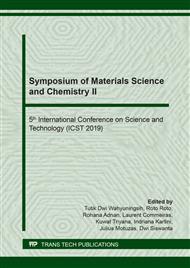[1]
Y. Qian, F. Chen, Y. Zhang, W. Tao, D. Han, X. Lu, Combustion and regulated/unregulated emissions of a direct injection spark ignition engine fueled with C3-C5 alcohol/gasoline surrogate blends, Energy 174 (2019) 779–791.
DOI: 10.1016/j.energy.2019.03.021
Google Scholar
[2]
M.N.A.M. Yusoff, N.W.M. Zulki, H.H. Masjuki, M.H. Harith, A.Z. Syahir, L.S. Khuong, M.S.M. Zaharin, A. Alabdulkarem, Comparative assessment of ethanol and isobutanol addition in gasoline on engine performance and exhaust emissions, J. Clean. Prod. 190 (2018) 483–495.
DOI: 10.1016/j.jclepro.2018.04.183
Google Scholar
[3]
S.G. Poulopoulos, C.J. Philippopoulos, The effect of adding oxygenated compounds to gasoline on automotive exhaust emissions, J. Eng. Gas Turbines Power 125 (2003) 344–350.
DOI: 10.1115/1.1501076
Google Scholar
[4]
A. Kyriakides, V. Dimas, E. Lymperopoulou, D. Karonis, E. Lois, Evaluation of gasoline–ethanol–water ternary mixtures used as a fuel for an Otto engine, Fuel 108 (2013) 208–215.
DOI: 10.1016/j.fuel.2013.02.035
Google Scholar
[5]
M. Amine, E.N. Awad, V. Ibrahim, Y. Barakat, Effect of ethyl acetate addition on phase stability, octane number and volatility criteria of ethanol-gasoline blends, Egypt. J. Pet. 27 (2018) 567–572.
DOI: 10.1016/j.ejpe.2017.08.007
Google Scholar
[6]
R. Oktavian, V. Amidelsi, A. Rasmito, G. Wibawa, Vapor pressure measurements of ethanol–isooctane and 1-butanol-isooctane systems using a new ebulliometer, Fuel 107 (2013) 47–51.
DOI: 10.1016/j.fuel.2013.02.005
Google Scholar
[7]
I. Gravalos, D. Moshou, T. Gialamas, P. Xyradakis, D. Kateris, Z. Tsiropoulos, Emissions characteristics of spark ignition engine operating on lower-higher molecular mass alcohol blended gasoline fuels, Renew. Energy 50 (2013) 27–32.
DOI: 10.1016/j.renene.2012.06.033
Google Scholar
[8]
V.F. Andersen, J.E. Anderson, T.J. Wallington, S.A. Mueller, O.J. Nielsen, Vapor pressures of alcohol-gasoline blends, Energy Fuels 24 (2010) 3647–3654.
DOI: 10.1021/ef100254w
Google Scholar
[9]
M.N.A.M. Yusoff, N.W.M. Zulkifli, H.H. Masjuki, M.H. Harith, A.Z. Syahir, M.A. Kalam, M.F. Mansor, A. Azham L.S. Khuong, Performance and emission characteristics of a spark ignition engine fuelled with butanol isomer-gasoline blends, Transp. Res. D. 57 (2017) 23–38.
DOI: 10.1016/j.trd.2017.09.004
Google Scholar
[10]
E. Christensen, J. Yanowitz, M. Ratcliff, R.L. McCormick, Renewable oxygenate blending effects on gasoline properties, Energy Fuels 25 (2011) 4723–4733.
DOI: 10.1021/ef2010089
Google Scholar
[11]
J. Sheehan, Engineering direct conversion of CO2 to biofuel, Nat. Biotechnol. 27 (2009) 1128–1129.
DOI: 10.1038/nbt1209-1128
Google Scholar
[12]
R.W. Rice, A.K. Sanyal, A.C. Elrod, R.M. Bata, Exhaust gas emissions of butanol, ethanol, and methanol-gasoline blends, J. Eng. Gas Turbines Power 113 (1991) 377–381.
DOI: 10.1115/1.2906241
Google Scholar
[13]
C. Berro, A. Pneloux, Excess gibbs energies and excess volumes of 1-butanol-n-heptane and 2-methyl-1-propanol-n-heptane binary systems, J. Chem. Eng. Data. 29 (1984) 206–210.
DOI: 10.1021/je00036a033
Google Scholar
[14]
V.R. Bhethanabotla, S.W. Campbell, P–x measurements for ethanol-n-heptane-isobutanol at 303.15 K, Fluid Phase Equilib. 62 (1991) 239–258.
DOI: 10.1016/0378-3812(91)80013-l
Google Scholar
[15]
J.H. Oh, I.C. Hwang, S.J. Park, Fluid phase equilibria isothermal vapor–liquid equilibrium at 333.15 K and excess molar volumes and refractive indices at 298.15 K for the mixtures of di-methyl carbonate, ethanol and 2,2,4-trimethylpentane, Fluid Phase Equilib. 276 (2009) 142–149.
DOI: 10.1016/j.fluid.2008.11.001
Google Scholar
[16]
S. Bernatová, J. Pavlícek, I. Wichterle, Isothermal vapor-liquid equilibria in the binary and ternary systems composed of 2,2,4-trimethylpentane, 2-methyl-1-propanol, and 4-methyl-2-pentanone, Fluid Phase Equilib. 307 (2011) 66–71.
DOI: 10.1016/j.fluid.2011.05.011
Google Scholar
[17]
A. Belabbaci, R.M. Villamanan, L. Negadi, C.M. Martin, A.A. Kaci, M.A. Villamanan, Vapor-Liquid Equilibria of Binary Mixtures Containing 1-Butanol and Hydrocarbons at 313.15 K, J. Chem. Eng. Data. 57 (2012) 114–119.
DOI: 10.1021/je200840e
Google Scholar
[18]
G.M. Wilson, Vapor-liquid equilibrium. XI. A new expression for the excess free energy of mixing, J. Am. Chem. Soc. 86 (1964) 127–130.
DOI: 10.1021/ja01056a002
Google Scholar
[19]
H. Renon, J.M. Prausnitz, Local compositions in thermodynamic excess functions for liquid mixtures, AIChE J. 14(1) (1968) 135–144.
DOI: 10.1002/aic.690140124
Google Scholar
[20]
D.S. Abrams, J.M. Prausnitz, Statistical thermodynamics of liquid mixtures: A new expression for the excess gibbs energy of partly or completely miscible systems, AIChE J. 21 (1975) 116–128.
DOI: 10.1002/aic.690210115
Google Scholar
[21]
G. Wibawa, A. Mustain, M.F. Akbarina, R.M. Ruslim, Isothermal vapor−liquid equilibrium of ethanol + glycerol and 2‑propanol + glycerol at different temperatures, J. Chem. Eng. Data. 60 (2015) 955–959.
DOI: 10.1021/je501019y
Google Scholar
[22]
R.P. Anugraha, A. Wiguno, A. Altway, G. Wibawa, Vapor pressures of diethyl carbonate + ethanol binary mixture and diethyl carbonate + ethanol + isooctane/toluene ternary mixtures at temperatures range of 303.15–323.15 K, J. Mol. Liq. 264 (2018) 32–37.
DOI: 10.1016/j.molliq.2018.05.049
Google Scholar
[23]
R.P. Anugraha, A. Altway, G. Wibawa, Measurement and correlation of isothermal binary vapor−liquid equilibrium for diethyl carbonate + isooctane/n‑heptane/toluene systems, J. Chem. Eng. Data. 62 (2017) 2362–2366.
DOI: 10.1021/acs.jced.7b00236
Google Scholar
[24]
B.E. Poling, J.M. Prausnitz, J.P. O'connell, The Properties of Gases and Liquids, 5th ed., Mc Graw Hill, New York, (2001).
Google Scholar
[25]
J.A. Barker, Determination of activity coefficients from total pressure measurements, Aust. J. Chem. 6 (1953) 207–210.
Google Scholar


